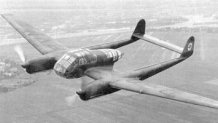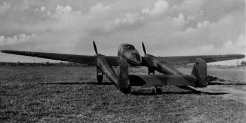
Focke Wulf Fw 189 UHU
Designer Kurt Tank selected the twin-boom configuration for the Fw 189, which had the advantage of allowing different fuselage nacelles to be used in the same basic airframe.
For its basic role of tactical reconnaissance, the Fw 189A's three man nacelle was extensively glazed and carried machine guns in the top and rear. There was a further machine gun in each wing, in addition to racks for a total of eight 50 kg (110 lbs) bombs. The aircraft entered service in late 1940, and went on to equip nine long range and 15 short range reconnaissance Gruppen, most of which served on the Eastern Front. Among its qualities were the agility to evade fighter interception and the strength and firepower to survive if it did come under attack. Some even survivied being rammed, managing to return to base with large sections of their tailfins missing.
The Fw 189B, a five seater with an enclosed nacelle, was intended fortraining but only a few were built. And the two seat 189C, which had a reduced sized, heavily armoured nacelle and was intended for assault and close support, was rejected in favour of the cheaper Hs 129.
Built in France and Czechoslovakia as well as at Focke-Wulf's Bremen factory during World War II, the Fw 189 was one of the Luftwaffe's most useful multi-role aircraft. Originally designed for tactical reconnaissance as a successor to the Hs 126, it was also used for casualty evacuation, ground support and night-fighting. In the process it earned an outstanding reputation for reliability and became popular with its pilots.
 |
 |
 |
| The Focke-Wulf Fw 189, piloted by its chief designer Kurt Tank, first flew in 1938, and was dubbed 'The Flying Eye' by the media. |
A very stable and rugged platform, the Focke-Wulf Fw 189 Uhu could absorb a certain amount of heavy calibre gunfire with little adverse effect on flight. |
Late in the war a number of Fw 189s were refitted as stop gap night fighters flying in Scandinavia. |
|
Focke Wulf Fw 189 UHU (Technical Specification) |
| Role |
Three seat tactical reconnaissance and army co-operation aircraft |
| Manufacturer |
Focke-Wulf |
| Maximum Speed |
350 kmh (217 mph) |
| Maximum Range |
670 km (415 miles) |
| Ceiling |
7,300 meters (23,950 feet) |
Weight
Maximum Takeoff |
4,170 kg (9,174 lbs) |
Dimensions
Wingspan
Length
Height
Wing Area |
18.40 meters (60 ft 4 in)
12.03 meters (39 ft 5 in)
3.10 meters (16 ft 2 in)
38.0 square meters (409 sq ft) |
| Engines |
Two Argus As410A-1 12-cylinder piston engines each providing 343.8-kW (460-hp) |
| Armament |
Six 7.9 mm (0.31 in) machine guns plus 400 kg (880 lbs) of bombs |
Photo Gallery
Click here to submit your photo
| Have A Passion For Aircraft? |
Subscribe to our 14 series FREE newsletter
delivered weekly on World War 2 Aircraft factfile... |
| NB:- We hate spam as much as you do, so your email address will NEVER be shared with or sold to anyone else. That's a Guarantee. |
|
|





